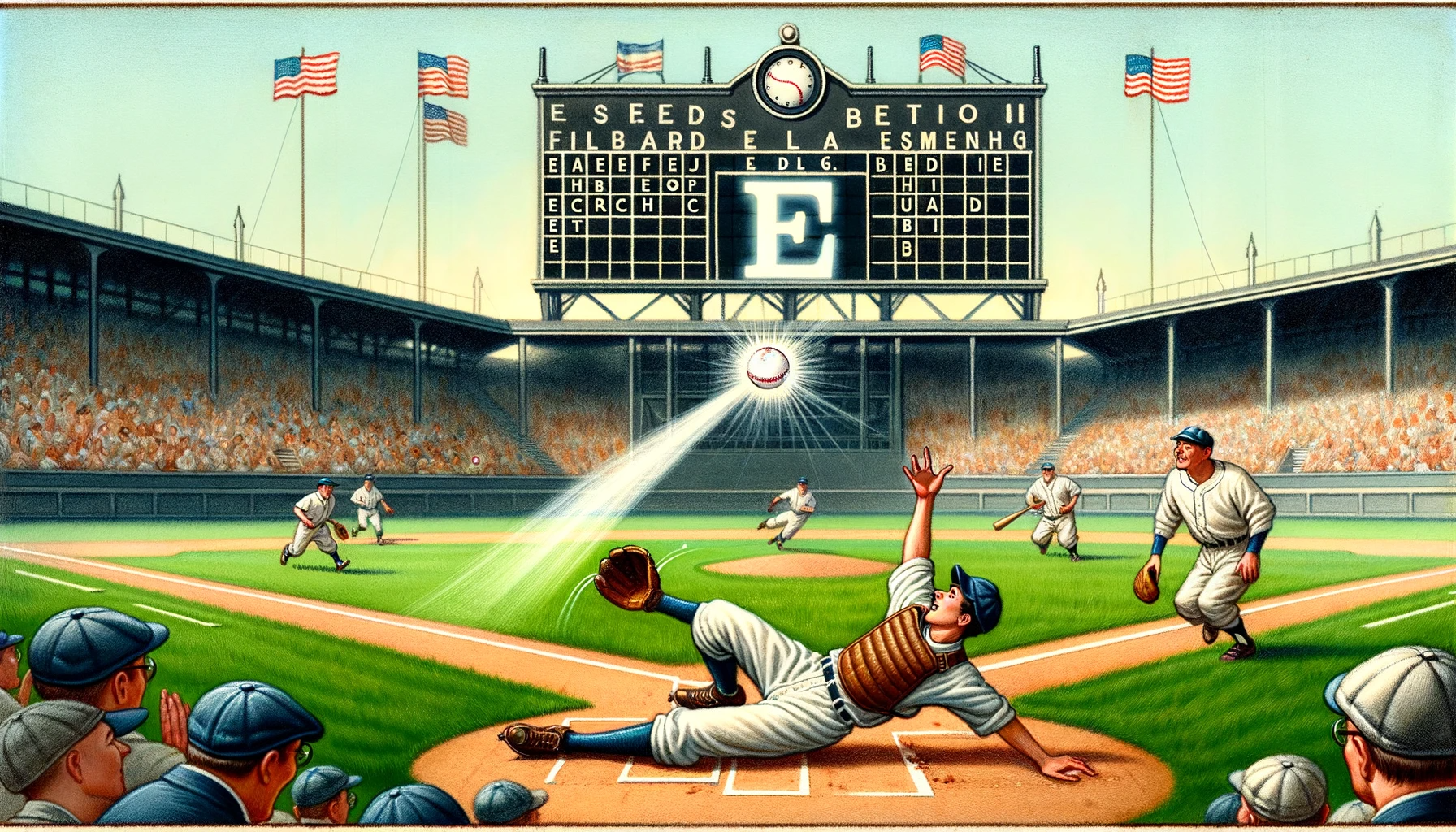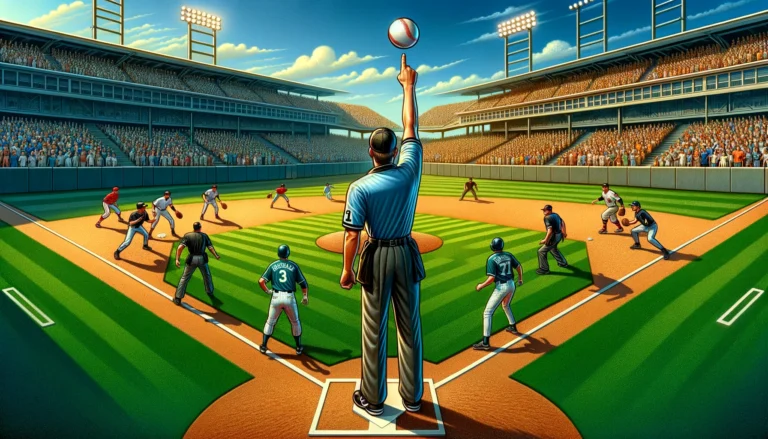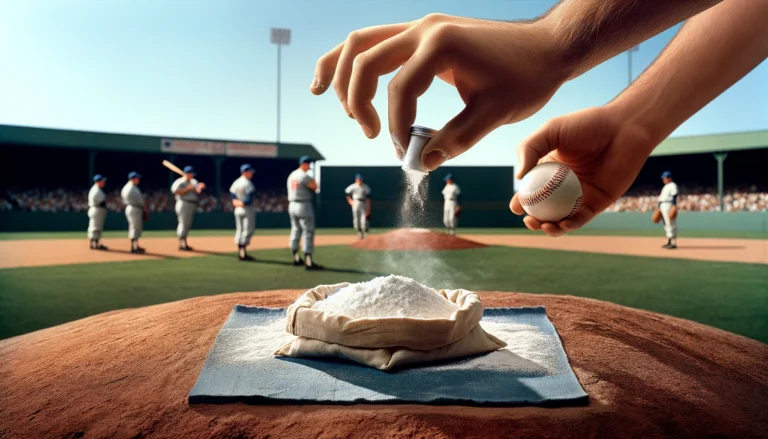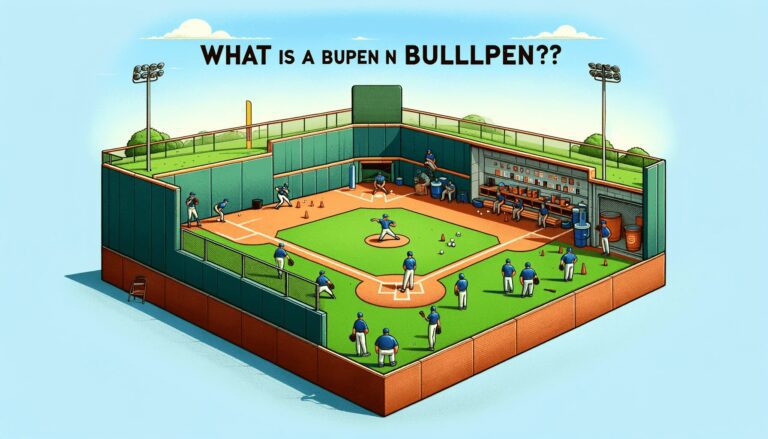What Does E Mean in Baseball?
In baseball, the letter ‘E’ stands for “error.” An error occurs when a player makes a mistake in the field that allows a batter or runner to advance one or more bases when, under ordinary circumstances, the player should have been put out.
This simple term can significantly impact a game, influencing both the score and the morale of the visiting team and players.
In this article, we will explain the concept of errors in baseball, helping you better understand and enjoy the game.
Key Takeaways
- The ‘E’ on a baseball scoreboard stands for ‘error,’ indicating a mistake made by a fielder that allows a batter or runner to advance.
- Errors can significantly impact the outcome of a game, affecting both the score and the morale of players and teams.
- Baseball categorizes errors into different types, such as fielding and throwing errors, each with its own consequences on the game’s dynamics.
- The recording and perception of errors have evolved over time, with historical incidents highlighting their critical role in baseball’s development.
- Errors play a crucial role in player statistics and are considered in advanced analytics, despite limitations in fully capturing a player’s defensive abilities.
Exploring the ‘E’ on the Scoreboard

The Basics of Scoreboard Symbols
A baseball scoreboard is a treasure trove of information, providing a snapshot at bat and of the game’s progress at a glance.
Among the various symbols and numbers, each has a specific meaning that conveys the game’s status.
Key symbols include ‘R’ for the runs scored, ‘H’ for hits, and ‘E’ for errors, which together paint a picture of both teams’ performance.
Runs indicate the total points scored, hits represent the the number of runs scored or times batters successfully reached base, and errors are mistakes by the defense that allow batters or runners to advance.
- ‘AB’ stands for at-bats, reflecting the number of times a player has been up to bat.
- ‘LOB’ denotes left on base, indicating the number of runners not scored.
- ‘SO’ or ‘K’ are used for strikeouts, showing how many times a pitcher has retired a batter with strikes.
Understanding these symbols is crucial for fans and players alike, as they provide essential insights into the unfolding drama of the nine innings.
Understanding the ‘E’ in Baseball Scoring
In baseball, the scoreboard is a quick reference guide to the game’s progress and events. One symbol on baseball scoreboards that often puzzles newcomers is the ‘E’ that appears on the board.
The ‘E’ stands for an error, a mistake made by a fielder that allows a batter or runner to advance one or more bases when, under ordinary circumstances, the player would have been put out.
Errors are recorded in the box and score sheet, which is a detailed account of the game’s events.
Here’s a basic rundown of how errors factor into scoring:
- An error is charged to a player who misplays a ball in a way that allows the game to proceed in an unintended direction.
- The error count contributes to the team’s defensive statistics, reflecting the team’s fielding performance.
- Unlike hits, walks, or home runs, errors do not credit the batter with statistical achievements but instead highlight a lapse in the fielding team’s defense.
Understanding errors is crucial for interpreting the game’s dynamics and can provide insight into a team’s defensive strengths and weaknesses.
How Errors are Reflected in Game Statistics
In baseball, errors are crucial for tracking a player’s defensive performance. An error is noted when a player mishandles a ball.
This mistake allows a batter, third baseman or runner to safely reach bases they shouldn’t have, assuming ordinary effort was made.
This stat is added to the player’s record. It also affects the team’s overall defensive effectiveness.
Errors contribute to several key statistics in the baseball game, including:
- The fielder’s fielding percentage is calculated as the number of putouts and assists divided by the number of total chances (putouts, assists, and errors).
- The pitcher’s ERA (Earned Run Average), as errors can lead to unearned runs which do not count against a pitcher’s ERA.
- The team’s defensive metrics, such as the Defensive Efficiency Ratio (DER), measure a team’s ability to convert batted balls into outs, including the impact of errors.
Understanding how errors influence these statistics is essential for evaluating a player’s defensive capabilities and the overall defensive strength of a team.
Read Also: What Does GIDP Mean in Baseball
The Impact of Errors in Baseball

Consequences of an Error on the Field
An error on the baseball field can have immediate and tangible consequences. Errors can shift the momentum of the game, often leading to unearned runs that affect the scoreline.
These mistakes can be particularly costly in tight games where every play counts.
- Errors can allow runners to advance extra bases, putting them in a better position to score.
- They can extend innings, giving the opposing team more opportunities to hit and score runs.
- Errors can also disrupt a pitcher’s rhythm, potentially leading to more hits and runs.
The psychological impact on the player who committed the error should not be underestimated. It can lead to a loss of confidence and increased pressure, which may result in further mistakes.
Errors and Their Effect on Player Performance
In baseball, player performance is often quantified by a range of statistics, but one aspect that can have a profound impact is the occurrence of errors.
Errors can significantly affect a player’s defensive statistics, leading to a higher Earned Run Average (ERA) for pitchers and affecting fielders’ fielding percentage.
These statistics are critical as they are considered by coaches, scouts, and analysts when evaluating a player’s overall performance and value to the team.
- Errors can lead to unearned runs, which do not count against a pitcher’s ERA but still reflect on the team’s defensive capabilities.
- For fielders, frequent errors can result in a lower fielding percentage, which is a measure of defensive reliability.
- Beyond the numbers, errors can also impact a player’s confidence and mental game, potentially leading to further mistakes or hesitancy on the field.
The psychological impact of errors should not be underestimated. A single error can shake a player’s confidence, and a series of errors, like the Oakland Athletics’ early errors in their 9-0 loss, can have a ripple effect on the entire team’s morale and performance.
It’s crucial for players to maintain a short memory when it comes to mistakes and for coaches to foster an environment where players can learn from errors without dwelling on them.
The Psychological Aspect of Errors for Players
The psychological impact of errors on baseball players can be profound and multifaceted. Errors can lead to a loss of confidence and increased pressure, which may affect a player’s performance in subsequent plays.
Players often experience a range of emotions after committing an error, including:
- Frustration with their own performance
- Embarrassment in front of teammates and fans
- Anxiety about possible consequences, such as being benched or criticized
Moreover, the fear of making mistakes can lead to a cautious approach to play, potentially hindering a player’s natural instincts and abilities.
In some cases, this can result in a vicious cycle where the anxiety of committing errors leads to more errors.
The mental game is as crucial as the physical one, and players may require support from coaches and sports psychologists to overcome the negative effects of errors.
The culture of the team and the support system in place play significant roles in how a player recovers from an error.
Verbal aggression, such as excessively criticizing a perceived unfair decision, are considered to be common behavior among people seeking to restore fairness, which can further exacerbate the psychological toll on a player.
Read Also: What Does BB Mean in Baseball
Different Types of Errors in Baseball

Fielding Errors Explained
In baseball, fielding errors are mistakes made by a defensive player that allow a batter or runner to advance one or more bases when such an advance should have been prevented with ordinary effort.
These errors are a critical part of the game’s scoring system and can significantly influence the outcome of a play or an entire game.
Fielding errors typically occur in several common scenarios:
- A fielder misplays a ground ball, either by fumbling it or failing to make a clean stop.
- A fly ball is dropped or misplayed in the outfield.
- A bad decision leads to a missed catch or tag.
It’s important to note that not all missed plays are considered errors. For instance, if a fielder makes a great effort but fails to catch the ball, it may be ruled a serious hit by pitch, rather than an error.
The official scorer’s judgment plays a key role in determining whether a play is ruled a hit or an error.
Throwing Errors and Their Consequences
Throwing errors occur when a player makes an inaccurate throw to a teammate, often leading to runners advancing on the bases or scoring.
These mistakes can be particularly costly, as they can change the momentum of the game and alter the scoreline in favor of line score or of the opposing team.
- A throwing error can allow a batter to reach base when they would otherwise have been out.
- It can permit runners to advance extra bases, sometimes even leading to runs that would not have been earned without the error.
- Over time, a player’s throwing accuracy is a critical component of their defensive skill set, and repeated errors can impact their position on the team.
The consequences of throwing errors extend beyond the immediate play. They can affect a player’s fielding percentage, a statistic that reflects their reliability in the field.
Moreover, persistent issues with throwing can lead to a loss of confidence, both in the player’s own abilities and from the coaching staff and teammates.
Other Miscellaneous Errors in Baseball
In addition to fielding and throwing errors, baseball encompasses a variety number of runs and other miscues that fall under the ‘E’ category on the scoreboard.
These errors are less common but can be just as impactful on the outcome of a game.
- Obstruction errors occur when a fielder illegally impedes a runner’s path, often leading to an advancement of bases.
- Catcher’s interference is when the catcher makes contact with the batter or his bat during a swing, which can grant the batter first base.
- Missed catch errors happen when a fielder fails to catch a ball that should have been caught with ordinary effort during a force play or pitch.
Understanding these additional errors is crucial for a comprehensive grasp of how the ‘E’ on the scoreboard affects the game beyond the more commonly seen fielding and throwing errors.
See Also: What Does R Mean in Baseball
Historical Perspective on Errors

Evolution of Error Recording in Baseball
The way errors have been recorded in baseball has undergone significant changes since the sport’s inception.
Initially, the concept of an error was informal, with scorers making subjective decisions on whether a play should have been made.
Over time, the criteria for what constitutes an error became more standardized, leading to a more consistent application across games and seasons.
In the early days of baseball, scorekeeping was a rudimentary practice, often left to the discretion of a single individual.
As the game professionalized, the need for uniformity in scoring became apparent. This led to the development of official scoring rules, which included detailed guidelines for recording errors.
The evolution of error recording can be broken down into several key phases:
- The establishment of the official scorer’s role and responsibilities.
- The introduction of specific criteria for judging plays as errors.
- The adoption of statistical categories to better reflect a player’s defensive performance.
- The ongoing refinement of error definitions to adapt to changes in the game’s complexity and skill level.
Notable Error-Related Incidents in Baseball History
Baseball history is peppered with incidents where errors have played a pivotal role in the outcome of games and the fates of teams.
One of the most infamous examples is the Black Sox Scandal of 1919, where eight members of the Chicago White Sox were accused of intentionally losing the World Series.
This event not only marred the reputation of the players involved but also cast a long shadow over the integrity of the sport itself.
Other significant error-related incidents include Bill Buckner’s misplay in the 1986 World Series and Merkle’s Boner in 1908.
Buckner’s error became a symbol of the curse that haunted the Boston Red Sox for decades, while Fred Merkle’s base-running mistake cost the New York Giants the pennant:
- The Black Sox Scandal
- Bill Buckner’s 1986 World Series error
- Fred Merkle’s base-running error in 1908
These events underscore the profound impact that errors can have, not just on the scoreboard, but on the legacy of home team, the players and the history of the game.
How the Perception of Errors Has Changed Over Time
The perception of errors in baseball has undergone a significant transformation throughout the sport’s history.
In the early days, errors were seen as an inevitable part of the game, often attributed to the challenging field conditions and rudimentary equipment. Players were not scrutinized as heavily for their mistakes on the field.
However, as the sport evolved, so did the expectations of player performance and the importance of defensive skills.
The introduction of advanced analytics and sabermetrics has further shifted the focus, with errors now being a critical metric in evaluating a player’s overall contribution to the team.
This has led to a greater emphasis on fielding proficiency and a more nuanced understanding of defensive play.
- The early leniency towards errors
- The rise of defensive importance
- The influence of advanced metrics
Today, while errors are still an accepted part of the game, they carry a heavier weight in terms of player evaluation and team strategy.
The stigma attached to errors can also affect a player’s market value and the decisions made by management regarding player positions and team composition.
Read Also: What Does AB Mean in Baseball
Conclusion
In conclusion, the ‘E’ on a baseball scoreboard is a critical indicator of errors made by the fielding team.
Understanding its significance helps fans appreciate the nuances of the game and the importance of defensive skills.
While errors can be disappointing for players and fans alike, they are an inherent part of baseball, reflecting the human element that makes the sport both unpredictable and compelling.
As we’ve unraveled the mystery of ‘E’ in baseball terms, it’s clear that every play, whether flawless or flawed, is a thread in the rich tapestry of the game’s history and tradition.
Frequently Asked Questions
What does the ‘E’ on a baseball scoreboard signify?
The ‘E’ on a baseball scoreboard stands for ‘error.’ It indicates that a player made a mistake in fielding, which allowed a batter or runner to reach a base or advance when they otherwise would not have.
How does an error affect the game statistics in baseball?
An error negatively affects a player’s fielding statistics and can impact team statistics as well. Errors contribute to unearned runs, which are the runs batted in that score as a result of defensive mistakes, not credited against the pitcher’s earned run average (ERA).
Can an error be charged to a pitcher?
Yes, pitchers can be charged with errors for mistakes made while fielding, such as mishandling a bunt or making a bad throw to a base.
What are the different types of errors in baseball?
The main types of errors in baseball include fielding errors, where a player mishandles a ball; throwing errors, which occur when a player makes an inaccurate throw; and other errors that can involve dropped catches or missed tags.
How has the recording of errors evolved in baseball history?
The recording of errors has evolved from a simple tally of mistakes to a more nuanced understanding of defensive play, incorporating advanced metrics to better evaluate player performance and the impact of errors on game outcomes.
Are errors considered in sabermetrics and advanced baseball analytics?
Yes, errors are considered in sabermetrics and advanced analytics, but they are often viewed in the context of other defensive metrics that provide a more comprehensive picture of a player’s defensive abilities.







